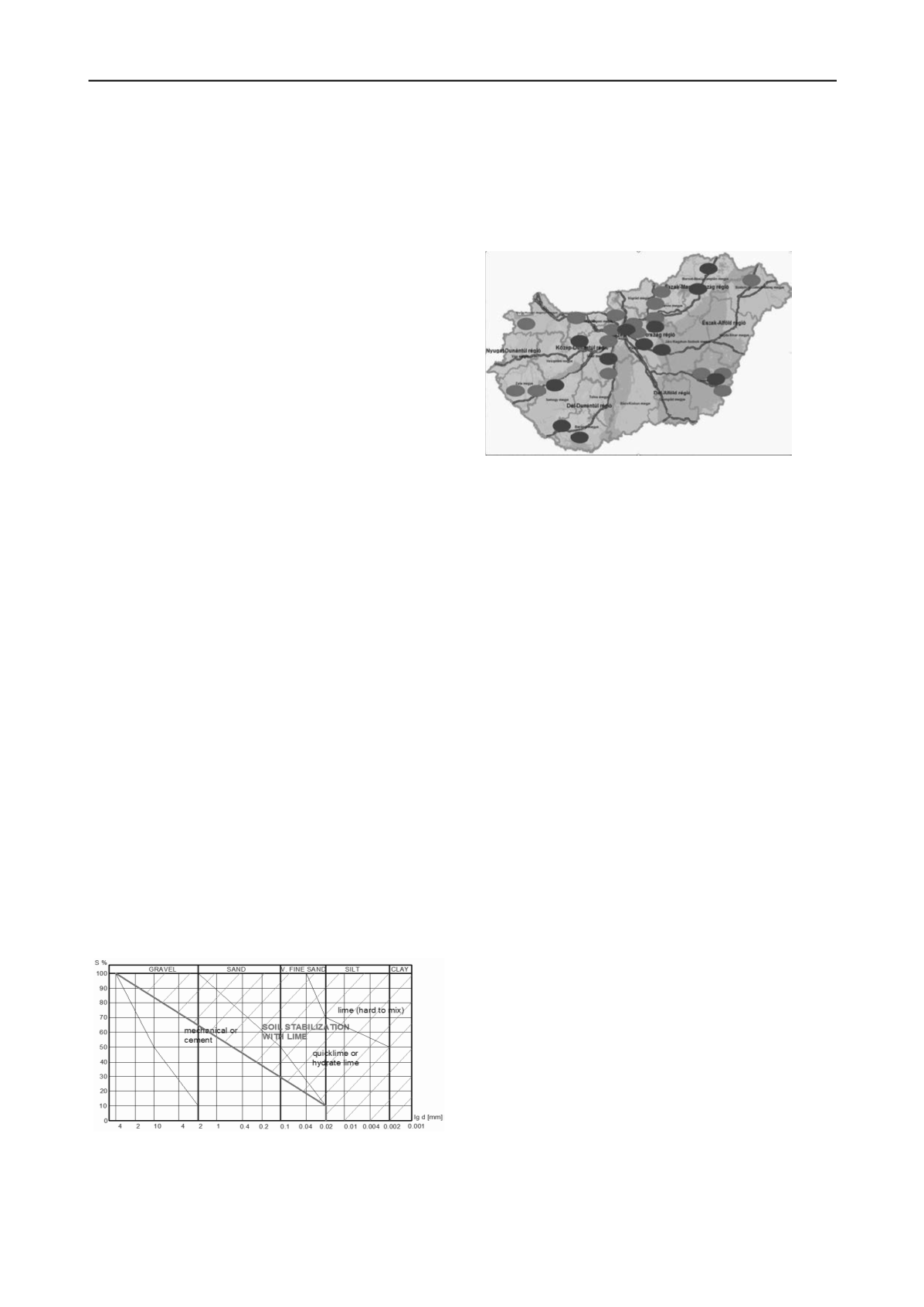
2602
Proceedings of the 18
th
International Conference on Soil Mechanics and Geotechnical Engineering, Paris 2013
damages on nature, and the transportation of thousands and
millions m
3
of materials to infrastructure and industrial plants
also results considerable load to the environment. Beyond the
above effects, this significant transportation also abrades,
damages and amortizes the already existing infrastructure.
2 GENERALLY ABOUT THE SOIL-STABILIZATION
WITH LIME
The soil-stabilization with lime is a successful and widespread
procedure for several decades in the USA and Western Europe,
while this technology is applied in Hungary and in the
neighboring countries only for the drying of sodden earthworks.
The research work was performed with Hungarian soils, with
the aim of supporting the work of designers and contractors to
use local soils as high bearing capacity layer and to reduce the
thickness of bedding and floors.
Mainly cohesive soils are used to be stabilized with lime,
however transient and clayey silty gravely soils can be
stabilized satisfactory based on my research. Therefore I
modified a figure of a generally used literature (Mitchell &,
Hooper, 1961.) about the types of suitable soils for stabilization
with lime with the modern machineries.
My suggestion based on my laboratory tests and field
experience is shown in red in Figure 1.
The stabilized layer can be built of materials mixed in situ or
at a distant site, however the soil is generally not moved but
worked in at the location of its original place, transforming it
into a layer of sufficient load bearing capacity. Bedding and
pavement layers are built on to the stabilized layer to achieve
the full layer system of a road, runway or industrial floor.
However in case of roads exposed to a lower traffic, forestry or
agriculture roads, the stabilized layer may also used as
pavement.
During the construction of the stabilized layer, the required
quantity of lime is spread over the previously executed surface
by a truck provided with a dosing head. The quantity of the lime
is 8-60 kg/m
2
depending on the thickness of stabilization and on
the type of soil. Subsequently the soil is mixed with the lime by
a remix machine. In case the process of stabilization requires
water, the modern remix machinery is able to add water through
the mixing head. Following mixing, the layer is compacted, and
the required ground level provided.
The lime improves the soil characteristics through chemical
reactions. Chemical reactions start with the mixing and may
take several decades. The chemical reactions during
the soil stabilization with lime are as follows:
dissolution of the lime
–
reduction of the water
content;
cation exchange-coagulation;
puzzolan reaction-cementation;
carbonatization
–
development of limestone.
Figure 1. Delimitation of grain size distribution areas from the point of
view of soil-stabilization with lime (Kézdi, 1967., Szendefy, 2008.)
3 DELINEATION OF MY RESEARCH
During the research 21 soils were measured in the laboratory
of Budapest University of Technology and Economics. The
origin soil properties of the measured soils are listed in the
Table 1. For the verification of the laboratory tests some in-situ
stabilization were analyzed as well.
Figure 2. Red spots show the origin of the soils for laboratory
measurements, blue spots show in-situ bearing measurements
After the literature 2, 4, 6% quick lime was added for the soils.
The quantity of the lime is the percent of the dried soil. Some
measurements was done with hydrate lime as well, but the final
determinations are given in quick lime, because it contains only
the agent (CaO), which is the unit of necessary active agent
My laboratory and field work included soil mechanics
parameters (plasticity, grain size, permeability, Proctor-test,
swelling), bearing capacity measurements (triaxial compression
test, CBR test, durability test) and geological tests (X-ray,
derivatograph, pH).
The soils were dried to the laboratory air humidity, than
were determined their moisture content and were determined the
quantity of the added lime. The lime and the required water
were mixed during 15 minutes than left it rest 45 minutes. After
resting they were remixed and compacted with Proctor-
machine. After compaction the mixtures were left for curing in
waterproof package.
To measure the time effect of soil-stabilization with lime I
made measurements 1 hour, 1 day, 3 days, 7 days, 14 days and
31 days after compaction.
I can show only a part of my research because the compass
of the article.
4 ALTERATION OF THE SOIL STRUCTURE
The clue of soil-stabilization with lime is an alteration of the
structure of soil caused by lime. Through the admission of lime,
the cohesive soils become crumbly, characterized by a reduced
plasticity.
4.1.
Alteration of plasticity
Several researchers pointed out that the plasticity index of
soils decreases even if a very low quantity of lime is added
(Wang, 1963., Jan, & Walker, 1963., Kézdi,1967., Nemesdy,
1983.)
They explain the reduction of the plasticity index with a
slight reduction of the liquid limit and with the drastic increase
of the plastic limit.
As I saw the clue of stabilization in the alteration of the soil
structure, I have performed experiments to find the exact
mechanism of changes of the plasticity index, and processed
literature data.
During the experiments, several soil types were tested
(Ip = 6.4 - 69.2 %), admixing 2 % - 4 % - 6 % of lime at
different ages.


